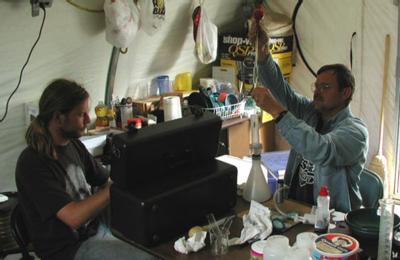22 July, 2000
July 22, 2000
Matanuska Glacier, Alaska
It appears as though we are finally making progress with our dye tracing
experiment. We still have to analyze the samples taken from Little River
Vent but we have measured dye coming out of both Mammoth Vent stations
that were sampled. We weren’t surprised at that outcome. But we were
fairly surprised to find nothing coming out at Trail Vent. We had
figured that even if some did come out of Trail Vent that it would also
have to come out at another location as well due to the water volumes
entering the moulin exceeding those exiting Trail Vent. Based on what
we’ve seen so far we don’t expect to see any dye coming out of Little
River Vent. Aside from being farthest away from the moulin, it also lies
northwest of the moulin. Both Mammoth vents and Trail vent are southwest
and west of the Little River Vent respectively. Since Trail Vent is
between the Mammoth Vents and Little River Vent it seems unlikely to
expect it to show up when we do the analysis.
What is now interesting to us is whether or not we would have seen
conductivity rises had we sampled the Mammoth Vents during our salt
experiments. There are probes that were collecting conductivity every
two hours at both Mammoth Vents but we cannot access that data. It is
doubtful that we would have seen it ourselves had we tested the water
that was collected there. At that time we weren’t controlling those
ISCOs and they were sampling every two hours. The dye flow that we’ve
observed has possibly come and gone within a two hour period. I say
possibly because we only took samples for a four hour period and we saw
dye for only two hours of that time period. Perhaps there’s still more
dye that flushed out after that time span. If the flow does go through
that quickly then we maybe would have seen just one high conductivity
point and would have thought it was just a fluke.
What we would like to do now is repeat the same experiment a second time
and possibly a third. We’re interested in seeing if similar results can
be produced. We at least hope to establish that the moulin definitely is
connecting to both of those Mammoth Vent stations. A second run could
confirm that notion. In this first test we’ve found a double peak
occurring at Mammoth-4. We’re not sure if there’s a similar feature at
Mammoth-1 but there seems to be something there at the end. (Recall that
there are numerous vents in this area and they are given different
numbers). We might be seeing a second and possibly third flow of dye at
Mammoth-1. We’re hoping to clear up that question with the second test.
We will do some things differently in the second run. We would like to
take samples for a longer period of time in order to determine whether
or not the dye has completed its course through the conduits. We’d also
like to take samples more frequently as well. It’s doubtful that we will
continue watching Little River or Trail Vents and so we won’t have an
increase in samples to analyze. That’s a good thing too as that part is
tedious and time consuming work.
Marvin Giesting

Ben is taking readings with the fluorometer as I prepare to filter another water sample.

This a comparison of the results at both Mammoth Vents. The shape of the concentration spikes is what we'd expect them to look like with a steep rise followed by a shallow decrease. We're not sure what to think of the little spikes at the end of Mammoth-1 (M-1). We hope the second run will give us more details.
Contact the TEA in the field at
.
If you cannot connect through your browser, copy the
TEA's e-mail address in the "To:" line of
your favorite e-mail package.
|
